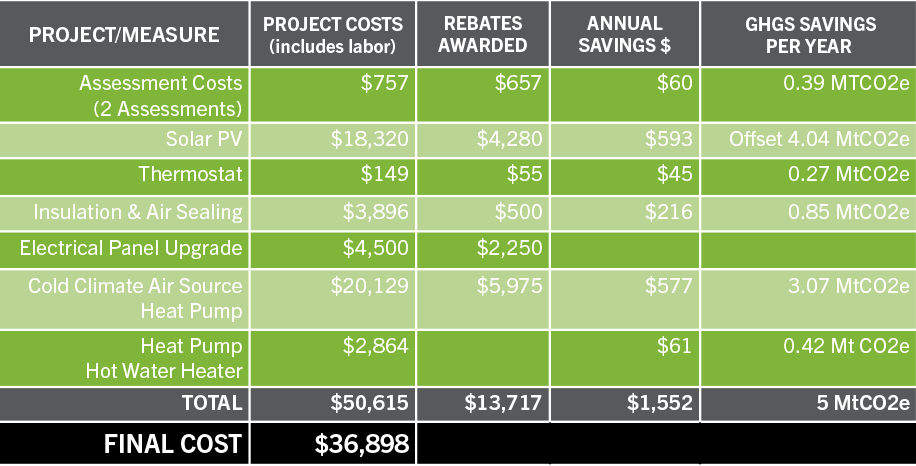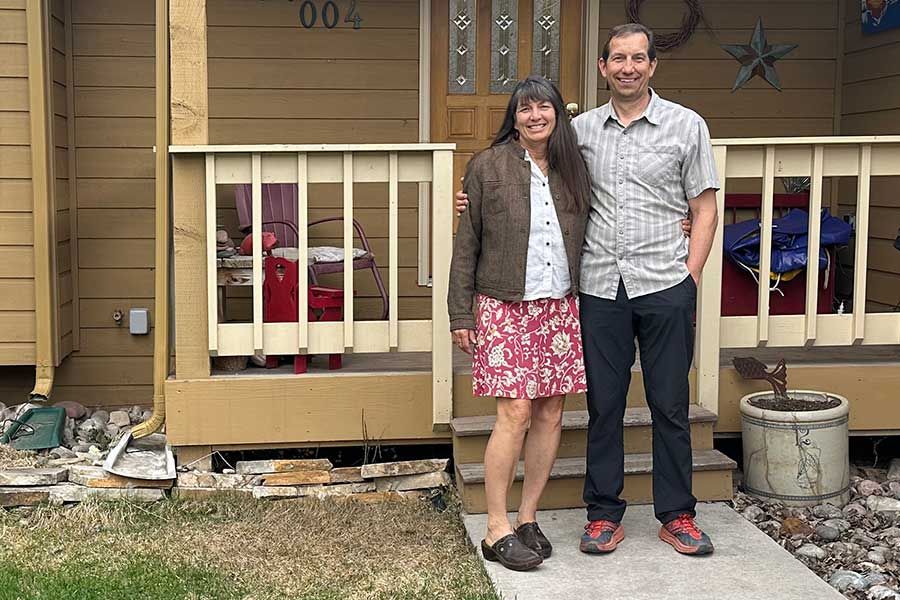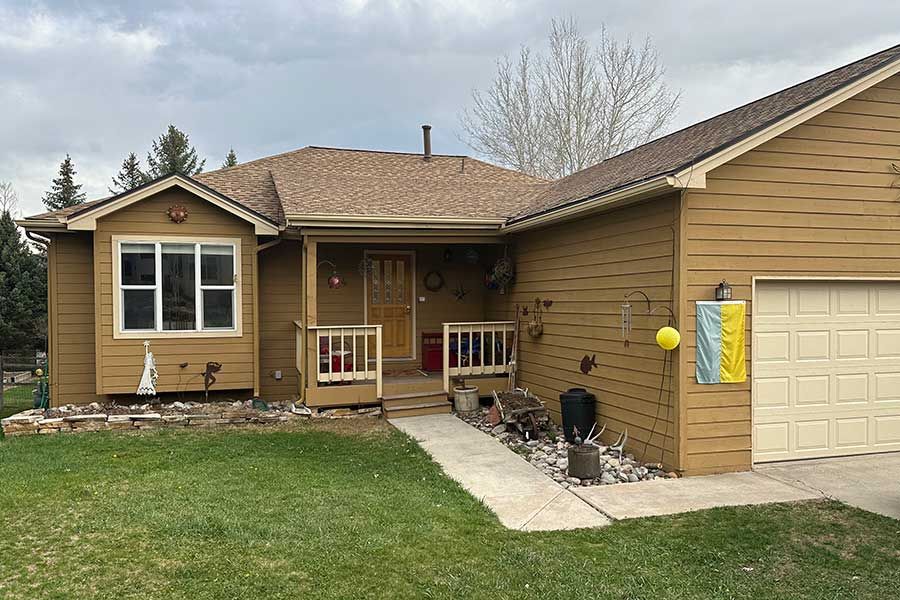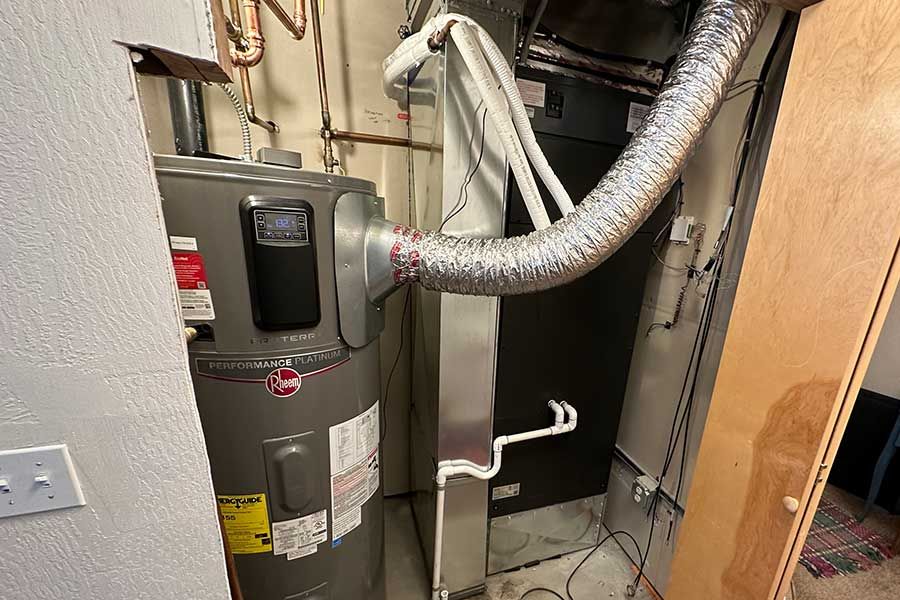From Fossil Fuel to Electrification
Swapping out his original gas furnace turned out to be a five-day project — one that Markian had hoped to complete in the summer — and the last bit of work was done on a Friday, while plug-in electric heaters blasted to keep the home at a comfortable temperature. If the heat pump didn’t function properly, it would be a long, cold weekend before the contractor could return on Monday.
Luckily, everything went smoothly, and on Saturday morning, when it was minus-15 degrees outside his home in Eagle, which sits at an elevation of 6,600 feet, Markian and his wife, Sue Nikolai, were warm and cozy in their newly electrified home.
“The cold-climate heat pump worked well from day one,” says Markian, who is president of Walking Mountains Science Center, a science and environmental education nonprofit in Eagle County.
In fact, Markian and Sue have yet to see any issues with the heat pump operating at super low temperatures. As the mechanical contractor, R&H Mechanical, explained, the “recovery” time takes longer to increase indoor temperatures when it’s cold outside, so some might choose to run the heater at a constant temperature, like 68 or 70 degrees. But like many, Markian and Sue prefer to sleep in cooler temperatures, around 64 degrees.
The couple sets their thermostat down to 64 degrees around 10:30 pm and then, to compensate for the longer recovery, the thermostat is programmed to bring the house back up to 68 degrees starting around 5:30 am. Unlike a gas furnace, it can take a heat pump up to two hours to return to 68 if it’s cold out.
“For us, this is a minor inconvenience and we could play with the set points more, but it doesn’t matter so much to us how long it takes to bring up the house temps,” Markian notes. “I’ve been really thrilled with it — it’s super energy efficient. What I didn’t expect is the dramatic drop in our utility bills.”
Where they used to spend around $4,000 per year on electricity and gas, according to Markian, now those utilities cost them $300 to $500 per year. The entire project — which started with installing solar panels, then tightening the building envelope, and finally adding an air-source hot water heater after the heat pump — cost around $50,000, so it’ll take several years before Markian realizes true savings. But it was worth it — in so many ways.
“There’s a lot more to home improvement than what’s aesthetic in nature like a kitchen or bathroom remodel. People shouldn’t underestimate how much this kind of work can improve your comfort and your health and safety, while also doing what’s best for the environment, making economic sense and adding value to your home.”
– Markian Feduschak
Assessment Process & Findings
Markian and Sue’s journey toward a more energy efficient, healthier, and more comfortable home began back in 2011, when they received their first home energy assessment. The assessment found that the three-bedroom home, which was built in the mid-1990s and has a walk-out basement level with two bedrooms, a study, and a mechanical room in the middle, was pretty leaky. Markian admits he “didn’t do enough” from the recommendations in that first assessment, which included improving insulation and air sealing, replacing furnace filters, adding thermal window curtains, and replacing bulbs with CFLs. A second assessment, conducted in 2020, provided many of the same recommendations, plus new ones due to exciting technological advances. And this time — having been empty nesters for a few years — Markian and Sue were ready to make the big changes.
“It was a values-based and economic decision for me,” says Markian, noting that he’s acquired a lot of knowledge thanks to his professional role (besides leading an environmental organization, he sits on the board of Energy Smart Colorado). “And the timing was right — this gave us something to do to fill the void and put all I had learned to good use.”
Energy Plan of Action
The first major step was installing a 5.04-kilowatt solar PV system, which was completed in November 2020. Next was the more multifaceted part of the project: sealing and insulating the home. This included replacing leaky recessed lighting with LED lights and sealing around the fixtures, sealing a gas fireplace with plexiglass, and properly insulating a dropped ceiling — all projects identified by a blower-door test that showed where air was leaking.
“When the contractor was done with his three- or four-days’ worth of work, I could tell the difference right away,” says Markian.
Besides improving comfort, the air sealing and insulation work reduced the size needed for the cold-climate heat pump, which was the next and biggest part of the project. Luckily, the ducted heat pump system replacing the gas furnace was able to use already installed duct work. The final piece of the puzzle — and the easiest, least expensive step — was installing a heat pump hot water heater. For this step (as well as for a few of the other small projects), Markian’s involvement in the project paid off. Doing his own research, he purchased the heat pump hot water heater and hired a plumber to install it. He was also able to install flexible ducting for the cold air exhaust by himself, which saved thousands of dollars overall from the quote he received from a mechanical contractor.
“The house just stays warmer in general due to the tighter building envelope and the fact that I was able to seal the air combustion vents from the old gas furnace,” Markian explained. “We constantly had cold air coming into the house through this vent, since we had an older combustion gas furnace that did not have sealed duct work.”
As of this writing, Markian and Sue have enjoyed over a year of living in their well-sealed, energy efficient home. Besides keeping the home warmer more efficiently in the winter, a heat pump acts as an air conditioner in the summer — a bonus that’s becoming increasingly necessary with hotter temperatures due to climate change. Previously, just the basement level stayed cool, except when windows had to be shut to keep out wildfire smoke — another more frequent climate change-era occurrence.
“We’re finally getting to sleep a lot easier,” says Markian.
So, what’s next? Markian might look into battery storage, to further capture solar energy during the two or three months that they currently pay for supplemental electricity from the grid. And installing an induction range. Besides that, it’s all about talking to friends, neighbors, and anyone who will listen about the project, and why it makes sense for anyone who cares about the environment, household finances, and their comfort, health and safety to take that first small step with an energy assessment — and see what’s possible.
Costs, Rebates and Energy Savings











